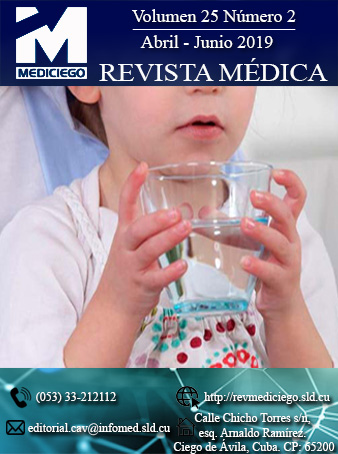Ultrasonografic diagnostic in acute colecystitis
Abstract
Introduction: abdominal ultrasound has a high value for the diagnosis of acute cholecystitis, a disease frequent in women and most often of lithiasic cause. Objective: to characterize the ultrasonographic diagnosis of acute cholecystitis. Method: a descriptive cross-sectional study was carried out in patients undergoing cholecystectomy, previous preoperative ultrasonographic diagnosis; at the Surgical Clinical Hospital "Manuel Ascunce Domenech" of Camagüey from August 2011 to July 2012. The universe was composed of 104 consecutively patients operated, which met the inclusion criteria and signed the consent to participate. Results: the age range was from 15 to 94 years, with an average of 48,32, the age group from 46 to 60 years prevailed and the female sex predominated. The diagnosis of acute cholecystitis was made almost exclusively by the clinical method, laboratory tests and abdominal ultrasound. The most frequent ultrasound finding was the positive Murphy sign followed by thickening with wall edema and vesicular lithiasis. However, respect to pathological anatomy tests, the diagnosis was not always coincident. Conclusions: the coincidence of the clinical and ultrasonographic diagnosis was high. As well as the concomitance between both, with the positive Murphy echographic sign, the thickening and edema of the vesicular wall, which were the most useful signs in the diagnosisDownloads
Published
How to Cite
Issue
Section
License
Copyright (c) 2021 Sahily Acosta Prieto, Bárbaro Agustín Armas Pérez, Ramón Ezequiel Romero Sánchez

This work is licensed under a Creative Commons Attribution-NonCommercial 4.0 International License.
Those authors who have publications with this journal accept the following terms of the License CC Attribution-NonCommercial 4.0 International (CC BY-NC 4.0):
You are free to:
- Share — copy and redistribute the material in any medium or format for any purpose, even commercially.
- Adapt — remix, transform, and build upon the material for any purpose, even commercially.
The licensor cannot revoke these freedoms as long as you follow the license terms.
Under the following terms:
- Attribution — You must give appropriate credit , provide a link to the license, and indicate if changes were made . You may do so in any reasonable manner, but not in any way that suggests the licensor endorses you or your use
- No additional restrictions — You may not apply legal terms or technological measures that legally restrict others from doing anything the license permits.
The journal is not responsible for the opinions and concepts expressed in the works, which are the exclusive responsibility of the authors. The Editor, with the assistance of the Editorial Committee, reserves the right to suggest or request advisable or necessary modifications. Original scientific works are accepted for publication, as are the results of research of interest that have not been published or sent to another journal for the same purpose.
The mention of trademarks of specific equipment, instruments or materials is for identification purposes, and there is no promotional commitment in relation to them, neither by the authors nor by the editor.






















